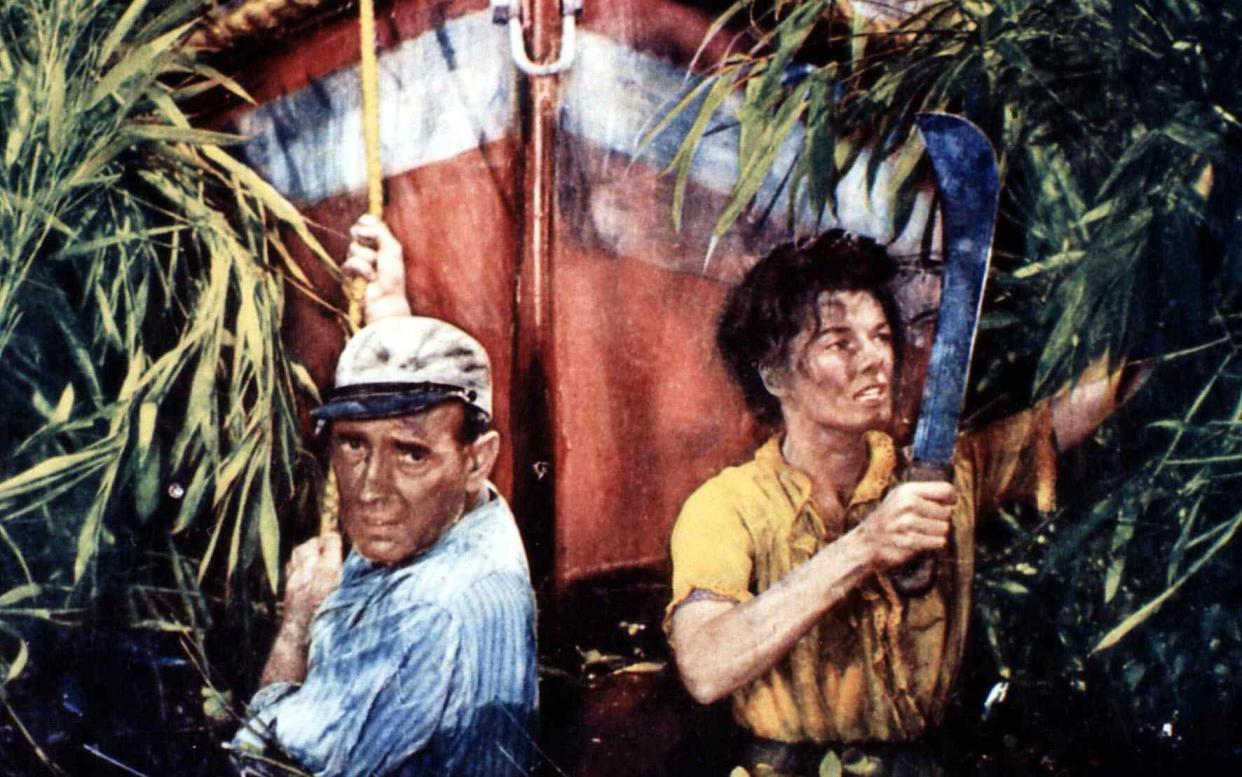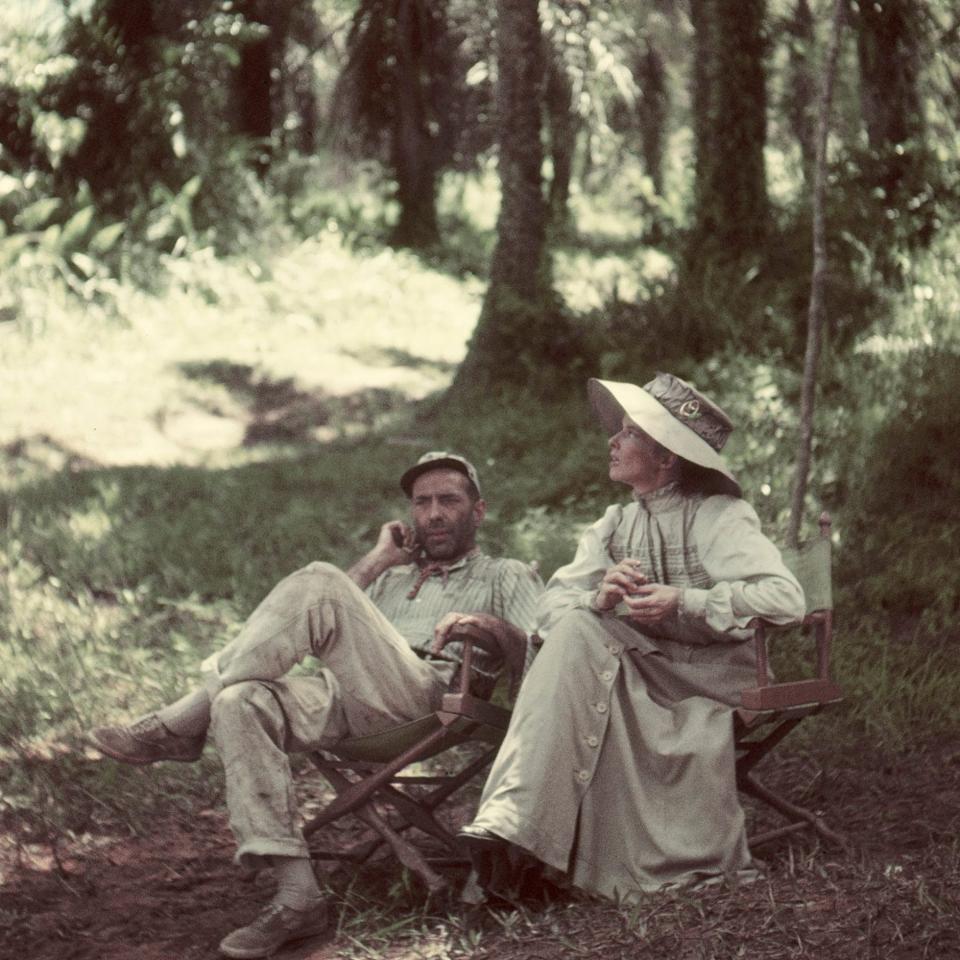The making of The African Queen: cannibals, killer hippos and Katharine Hepburn’s floating loo

“Do it? Of course we can do it – nothing a man can’t do if he believes in himself. Never say die, that’s my motto.”
Those were Bogie’s words to Katharine Hepburn in The African Queen. Or more specifically, the words of Humphrey Bogart’s gin-sozzled captain, Charlie Allnut, to Hepburn’s well-to-do missionary, Rose, about their self-appointed mission: to ride the Ulanga River and take out a German gunboat by using Charlie’s clapped-out steamer – the African Queen herself – as a makeshift torpedo.
Behind the camera, the never-say-die motto rang just as true for director John Huston. A maverick, adventuring “man’s man” who stood outside the Hollywood studio system, Huston steered production on what seemed like an impossible journey: a film made on location – a rarity in 1951 – and filmed in Technicolor, which meant lugging a camera encased in a hefty 4ft x 2ft box around the Belgian Congo and Uganda.
Making the film became a fight for survival: savage beasts, vicious bugs, amoebic dysentery, malaria, searing heat, and – so John Huston claimed – cannibals. At one point, The African Queen was a literal sinking ship. So wild was the experience that Katharine Hepburn later wrote a book titled The Making of The African Queen, or How I Went to Africa with Bogart, Bacall and Huston and Almost Lost My Mind.
Now Disney’s Jungle Cruise, starring Dwayne Johnson and Emily Blunt, is sailing down the river for a contemporary retread. And yet it’s hard to imagine Disney putting its modern stars anywhere close to the kind of danger on which John Huston thrived 70 years ago.
Huston hadn’t yet completed work on The Red Badge of Courage when he decided to make The African Queen. The original novel, by CS Forester, was published in 1935. Set in German East Africa at the start of the First World War, the story sees Germans storm a village to conscript the natives – forcing Charlie and Rose to head down the river together.
Huston embarked on the mission with Sam Spiegel, a chutzpah-heavy producer who had fled Nazi Germany, been jailed for fraud, and made the heavyweight classics Lawrence of Arabia, Bridge on the River Kwai, and On the Waterfront. By 1951, however, The African Queen had been struggling to stay afloat in Hollywood for several years. Both Colombia and Warner Bros had owned the rights but never put it into production.
Spiegel, exuding his skill for finding money, loaned the $50,000 needed for the rights from a sound equipment company, promising them interest and a namecheck in the film’s credits. The British producers John and James Woolf largely financed production, lured in by the star names of Bogart and Hepburn. There are conflicting stories about how the stars were signed up. One account says that Bogart recommended Hepburn for the role. Hepburn’s book claims it was the other way round and she recommended Bogie.
For Hepburn – who partly signed on for the allure of Africa – the film was stressful long before they reached the continent. She was troubled by the vagueness of Huston’s plans: the script, the financing, the loose arrangements.

Huston had enlisted the critic and author James Agee to write the screenplay. “The best motion-picture critic this country has ever had,” the director wrote. The writer had impressed him with a review of Huston’s Second World War documentary, The Battle of San Pietro – “I sent him a note of appreciation, the one and only time I have ever addressed myself to a critic” – and a Life magazine article about Huston titled “Undirectable Director”.
For the characters of Charlie and Rose – polar opposites thrown together, destined to fall in love as they survive the rapids and evade gunfire – Agee took inspiration from his own parents. But he didn’t complete the script. His lifestyle – heavy drinking and smoking, long hours of writing, daily tennis sessions with Huston – caught up with him. He had a heart attack before the screenplay was finished, and while he survived, he would die of another one just a few years later. Screenwriter Peter Viertel travelled to Africa with Huston and finished the script. (Viertel later wrote a book, White Hunter Black Heart, about his experiences making the film, which became a 1990 Clint Eastwood film; Eastwood played “John Wilson”, a fictionalized version of Huston.)
Huston selected locations near the Ruiki river, in the Belgian Congo, and Lake Albert and Murchison Falls in Uganda. Near the Ruiki location, the crew built a compound made from palm leaves and bamboo, which had to be surrounded by kerosene-filled trenches – a last line of defence against soldier ants. The trenches could be set ablaze if the ants attacked. “If a goat is tethered, they will leave only his bones,” wrote Huston about the ants. (Later, the ants did mount an “exploratory” invasion. Hepburn led the fight against them.)
While the compound was under construction, and before the bulk of the cast and crew arrived, a local hunter was charged with finding meat for the production’s pot. According to Huston’s autobiography, this pot was filled with “monkey, forest pig, deer and you-name-it”. But soon enough, soldiers marched into the village and arrested the hunter. He was hanged a few days later. Villagers, explained Huston, had been disappearing – the hunter was snatching them as a meat substitute.

“I must say I couldn’t tell the difference in the taste,” Huston wrote. “I was thankful that the ‘long pig’ was served before the main group arrived. Only a few of us were privileged to dine so exclusively.” (Assistant director Guy Hamilton, on the other hand, found that story hard to swallow: “Absolute bulls---.”)
When Bogart and Hepburn arrived in the Belgian Congo, Huston didn’t bother to meet them. This was, Hepburn said, “an utterly piggish thing to do”. He had gone off to try to shoot an elephant. Huston admitted that killing one would have been more than a crime – even a “sin” – and Hepburn protested at first, but Huston insisted she join him. She quickly came to enjoy it, and was fascinated by the idea of seeing Huston kill. She never killed herself, but carried his rifle. “She used to come and wake me up in the early morning,” Huston later wrote, “so we would have an hour’s shooting before the day’s work.”
During one hunt, Huston and Hepburn found themselves among a herd of elephants – a perilous situation of gigantic proportions. They escaped unharmed, but Huston realised how irresponsible it had been: he almost got his leading lady trampled. Bogart was unimpressed. “That son-of-a-bitch has gotten to you,” he told Hepburn. Bogart, by contrast, was more relaxed on location, preferring to drink scotch and tell stories. Between his scenes, he would cobble together a bed and sleep until he was needed again. (Huston, meanwhile, never did kill an elephant.)

The African Queen itself was a British-built steam boat, 30ft long and made in 1912. The crew also built a second African Queen on a raft, which had mocked-up sections of the boat for up-close shots, plus a series of other rafts – all trailing behind the actual African Queen in a flotilla. The rafts each carried different essentials: one for the camera and technical equipment; another for their generator; even one for Hepburn’s personal loo. The actress was reported to have personal facilities written into her contract; she wrote about the anxiety of not wanting to defecate in the cubicle next to Bogart, whom she barely knew. But after Hepburn’s floating toilet became caught in some trees, it ultimately had to be cut loose.
The African Queen fared badly herself. One morning, the crew woke up to discover that she had sunk. Huston recalled telling Sam Spiegel the bad news over the radio. Spiegel laughed: “I thought you said the Africa Queen sank!” “That’s right,” Huston replied. “Oy!” cried Spiegel. The crew, including Bogie himself, had to pull the boat back out using ropes.
With Hepburn’s toilet lost to the river, other facilities were much sought-after – diarrhoea was, unsurprisingly, rife. “There were three to four people waiting at all times to get into our portable outdoor toilet,” said Huston. In one desperate moment, crew member Kevin McClory fled the loo when a black mamba slipped in alongside him.

There were many more animal encounters: stinging black wasps; giant crocodiles on the riverbanks; a hippo that lifted the boat from beneath the water; and jiggers – parasitic bugs that burrow into the skin – between Bogie’s toes. The film also found an unlikely audience in a gang of baboons who came to watch every day. (You can hardly blame them: Bogart is magnificent – a true Golden Age performance – and Hepburn blossoms, stern and reserved at first but coming to life as the adventure trundles downriver.)
When the production reached Butiaba, at Lake Albert, a local king promised Huston some villagers to act as extras. It was a while before they showed up – they were afraid of lurking cannibals, Huston claimed. After moving to Murchison Falls, the crew was struck down with extreme sickness, due to faulty water filters. The crew was drinking straight from the lake. “With the droppings of hippos and crocodiles,” said cinematographer Jack Cardiff. Bottled water was rushed in via train, but it was also contaminated.
The crew was disease-stricken. Lauren Bacall, who hadn’t been cast in the film but had travelled with husband Bogart for the duration, became their cook, nurse and all-round saint. Huston and Bogart were the only ones to avoid sickness, because they drank scotch instead of water. (“They were great friends – and great drinking friends,” Bacall said.) Hepburn, however, who was teetotal, got so ill that for one scene early in the film – in which she plays the organ to the natives – she needed a bucket at her feet and vomited between takes. (In these scenes, you can spot the unmistakable glistening of fever on her face.)

Eventually, for the final scenes, the production moved to London, and created one of the capital’s great urban legends: that The African Queen was responsible for introducing London’s invasive population of parakeets. The birds, so the legend goes, were brought in to recreate jungle scenes. Though this was long dismissed as just a story, zoologist Hana Ayoob has claimed that it could be true: her grandparents lived near the studios and recalled the parakeets suddenly appearing in the garden; her grandfather even fed them.
The African Queen premiered in December 1951. Its success took the filmmakers by surprise. A falling out between Huston and Spiegel had caused Huston to dissolve business together – meaning that Huston lost out on the huge, unexpected box-office takings. Most surprised of all, perhaps, was Bogie himself, who was convinced that he wouldn’t win an Oscar for the film. As detailed in the documentary Embracing the Chaos, the filmmaker Richard Brooks told his longtime friend that if he did win, he should go slowly to the podium and just say, “It’s about time.”
At the 24th Academy Awards in March 1952, Bogart won Best Actor, beating Marlon Brando and Montgomery Clift. He was flabbergasted, and forgot his line. Instead, he thanked everyone and welled up. “What happened?” Brooks asked him afterwards. “Tell you what,” replied Bogie. “When you get yours, you do it.”


